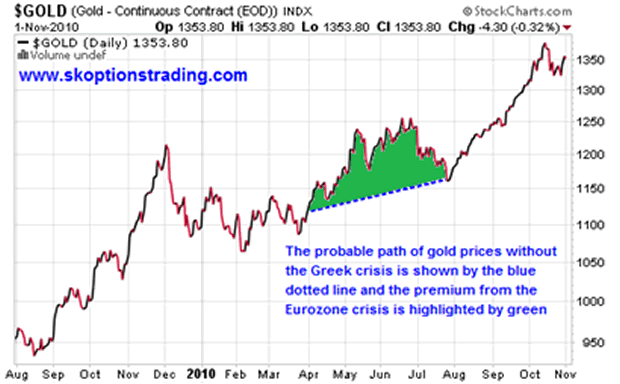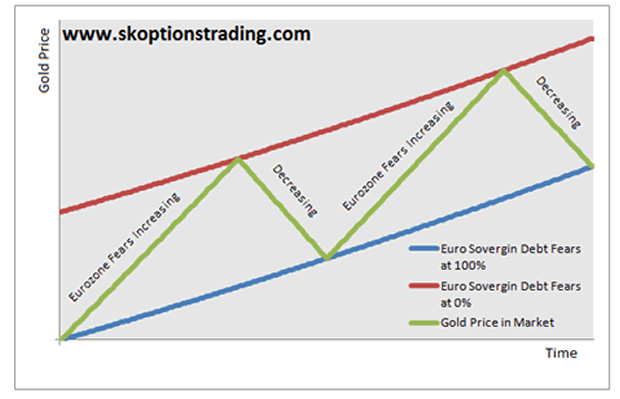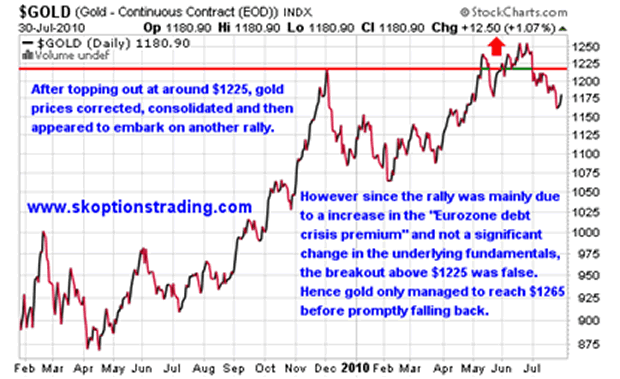Trading Gold and Its Eurozone Crisis Premium
Commodities / Gold and Silver 2011 Jun 29, 2011 - 03:06 AM GMTBy: Bob_Kirtley

 Recently gold challenged it’s all time highs, being propelled largely by renewed concerns over the Greek debt crisis and the possible ramifications a default could have on global financial markets. Whilst fears of a possible default in Greece are supportive of gold prices in the short term, it is important to understand that such pressures are largely temporary in nature and they do not significantly change the underlying market dynamics in the longer term. We feel the best way to describe this is by way of visualizing that there is a premium built into the gold price that varies with regard to how prevalent fears over the Eurozone crisis are. Just to clarify, we are considering the effect that fluctuations in fears over the Greek situation have on the gold price, not the effect that an actual default would have on the price. When fears escalate, the gold price increases and when fears subside, then so does the gold price. It does not necessarily significantly alter the overall direction of gold prices over the longer term.
Recently gold challenged it’s all time highs, being propelled largely by renewed concerns over the Greek debt crisis and the possible ramifications a default could have on global financial markets. Whilst fears of a possible default in Greece are supportive of gold prices in the short term, it is important to understand that such pressures are largely temporary in nature and they do not significantly change the underlying market dynamics in the longer term. We feel the best way to describe this is by way of visualizing that there is a premium built into the gold price that varies with regard to how prevalent fears over the Eurozone crisis are. Just to clarify, we are considering the effect that fluctuations in fears over the Greek situation have on the gold price, not the effect that an actual default would have on the price. When fears escalate, the gold price increases and when fears subside, then so does the gold price. It does not necessarily significantly alter the overall direction of gold prices over the longer term.
We think it is important to understand how changes in this “Eurozone debt crisis premium” impact the gold price. Distinguishing between price swings caused by fears over Greece and price swings that occur when a true fundamental or structural change has taken place in the market is imperative for valid and reliable market analysis.
For instance the quantitative easing programs implemented by the Federal Reserve are examples of events that truly changed the market fundamentals for gold and triggered a significant and sustainable rise in prices. Fears over the Greek crisis may cause the gold price to move, often significantly, but once fears subside the price will come right back. This is because the degree to which people are afraid of turmoil in Greece has not changed significantly, the underlying structure of the gold market.

To demonstrate this point we will take a look back to around this time last year, when the Greek issue was dominating the headlines and there was plenty of fear in the market around a possible default. Then the bailout package came though, fears subsided and gold prices fell back. The chart below illustrates the accumulation and erosion of the “Eurozone debt crisis premium” in gold prices at the time.
Gold had undergone a correction from December 2009 to February 2010 and was in a consolidation phase during a seasonally weak time of year when concerns over Greece began to make headlines. This caused an increase in the “Eurozone debt crisis premium” and therefore an increase in gold prices. However, it did not trigger a major rally as it did not alter anything fundamental in the gold market.
The market dynamics at work here are as follows. Traders and investors were concerned over the Greek situation and therefore gold was bought as a safe haven or hedge against the financial turmoil that could follow a Greek default. As the bailout package came through, the probability of a default decreased and therefore those who were long gold as a hedge against a crisis began to unwind their positions. This is what we are defining as the “Eurozone debt crisis premium” and the erosion of this premium contributed to the 8% fall in gold following the bailout. Without the fears over Greece, we think that gold prices would have likely followed a path similar to the blue dashed line on the chart above.
Just as an increase in the premium did not signal a new major rally in gold, a decrease in this premium did signal a downtrend. Changes in this premium do not significantly affect the overall trend or market fundamentals.
Another way to picture this is to presume that fears over Eurozone debt can be measured on a scale of 0-100%, with 100% meaning that the market is as fearful of a default as it can be and 0% being equivalent to the market not having any fears of a default. When this measure is at 100%, the “Eurozone debt crisis premium” is fully priced into gold and when it is 0% it is not priced in at all.
Without the “Eurozone debt crisis premium” gold prices would still follow on the path set by the fundamental factors that move gold significantly and sustainably over the longer term, such as quantitative easing.

This is obviously a large simplification, but we are merely trying to make the point that changes in fears over the PIIGS and the subsequent “Eurozone debt crisis premium” is more like changing the intercept of the gold bull market trend than the gradient.
So why is this important? After all changes in the price of gold, whether due to changes in the “Eurozone debt crisis premium” or any other factor, are still changes in price and so impact our gold positions. Well we think this is important for two main reasons.
Firstly a rise in gold due to an increase in the “Eurozone debt crisis premium” is not necessarily sustainable and therefore can impact the validity of technical analysis. An example of this was seen last year, when a rise in the gold due to Eurozone concerns sent prices to a new all time high. However shortly after this breakout prices retreated and therefore we consider this a “false breakout”. Trading this breakout from a purely technical perspective could have led to losses since gold did not go on a run after this break out. This emphasises the importance of understanding the fundamental dynamics of the gold market and combining them with technical analysis to reach a more reliable conclusion.

We noted the similarities in recent market action and the situation last year in an update to SK OptionTrader subscribers on June 21st, just a day before gold prices topped out and fell over $50, saying:
“The Greek crisis and fears of contagion have prompted a fair amount of safe haven buying and have kept gold prices reasonably well supported. However should the situation in Greece improve with say another bailout (or be perceived to improve) then these safe haven hedges could begin to unwind, creating a downward pressure on the gold price.
“We saw a similar scenario unfold in 2010 when gold prices gradually ticked upwards, even setting a new all time high at $1265 before falling back to around $1150 shortly afterwards. Given that the 2010 spring rally was also driven by Greek debt concerns, we are getting a feeling of déjà vu when we observe the markets. Therefore although a new all time high in gold would cause us to seriously consider taking a long position again, any technical breakout to a new high would have to be supported by some fundamental reasoning as to why gold was about to embark on a major rally. This is important as there is a big difference between a breakout that signals the start of a major move and a breakout that is caused mainly by a lot of safe haven hedge positions in gold that could be easily unwound should the Greek crisis subside.”
The second important reason for indentifying and understanding why gold prices are rising is that it should affect what type of vehicle one uses to trade or invest in gold’s movements. This mainly affects whether gold stocks should play a part in your position or not. Whilst we tend to avoid gold stocks (for reasons that will require a separate discussion), many investors use them to benefit from gains and falls in the price of gold.
Using gold stocks to benefit from a rise in gold prices may be a decent idea if the anticipated price movement is due to a fundamental change in the gold market that will cause a sustainable increase in prices, such as the implementation of quantitative easing programs. However it is not a good idea if the movement is due to something like the Greek debt crisis.
The logical reasoning why gold stocks have performed poorly in the recent run up in gold prices is as follows. Suppose there were two outcomes from the situation in Greece. One is that some form of bailout package is given and fears over the sovereign debt situation subside. The other is that Greece defaults on its debt and financial markets go into turmoil.
Whilst it may be debatable how gold prices will behave under each scenario, neither outcome is positive for gold stocks. The first would probably see gold prices rally temporarily and then subside as fears abated. How much more valuable are gold stocks if the gold price is higher for a month or so? Chances are it doesn’t have a great impact on how much money the companies are going to make and therefore the stocks aren’t worth that much more under this scenario. With the second outcome, it is likely there would a massive flight from risk assets across all markets and a scramble for liquidity. That means gold stocks would be sold, as after all they are still equities and therefore would be dumped in a dash for cash.
Therefore if one wishes to trade gold on the back of fluctuations in fears over a Greek default, gold stocks should play no part in that strategy. In fact one could even make the argument that the best trade for that type of situation is a long gold/short gold stocks position, but we digress.
In conclusion our main point is that we think it is important that one understands how the “Eurozone debt crisis premium” impacts the gold market and the ramifications that price movements caused by the changes in this premium have on how one analyses and trades gold. This is an example of the analysis that we undertake at SK Options Trading, pass on to subscribers of SK OptionTrader via trading signals and market updates. Gold is a major focus of our trading and we use options on US equities such as GLD in an attempt to profitably trade gold. SK OptionTrader has recommended 61 gold related trades since inception and 60 of those have been profitable, a success rate of 98.36%. Overall our model portfolio is up 338.11% since inception and we have an average return of 40.14% per trade including losses. Our full trading record is available at www.skoptionstrading.com so feel free to visit the site for more information and to sign up.
To stay updated on our market commentary, which gold stocks we are buying and why, please subscribe to The Gold Prices Newsletter, completely FREE of charge. Simply click here and enter your email address. (Winners of the GoldDrivers Stock Picking Competition 2007)
For those readers who are also interested in the silver bull market that is currently unfolding, you may want to subscribe to our Free Silver Prices Newsletter.
DISCLAIMER : Gold Prices makes no guarantee or warranty on the accuracy or completeness of the data provided on this site. Nothing contained herein is intended or shall be deemed to be investment advice, implied or otherwise. This website represents our views and nothing more than that. Always consult your registered advisor to assist you with your investments. We accept no liability for any loss arising from the use of the data contained on this website. We may or may not hold a position in these securities at any given time and reserve the right to buy and sell as we think fit. Bob Kirtley Archive |
© 2005-2022 http://www.MarketOracle.co.uk - The Market Oracle is a FREE Daily Financial Markets Analysis & Forecasting online publication.


